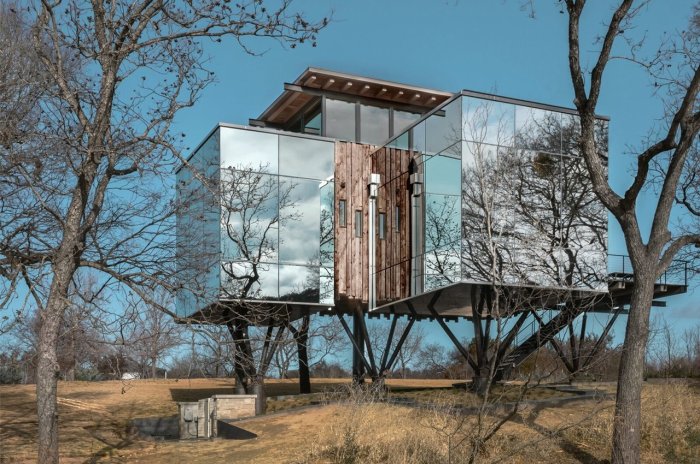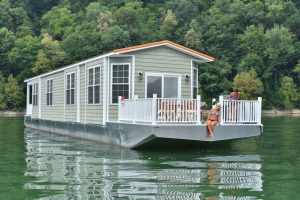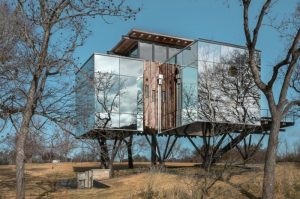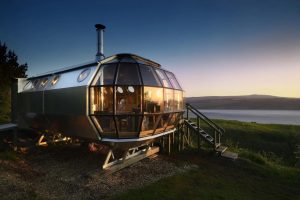
Floating treehouses offer a unique blend of adventure and tranquility, unlike traditional treehouses or other accommodations. Imagine waking up to the gentle sway of water, surrounded by breathtaking natural beauty. These innovative structures, often perched over serene lakes or meandering rivers, provide a truly unforgettable escape. Their designs vary widely, from rustic and minimalist to luxurious and modern, each offering a distinct experience tailored to different preferences.
This exploration delves into the design, location, experiences, and market potential of floating treehouses, comparing them to similar accommodations and highlighting their unique appeal. We will examine the environmental considerations, the diverse range of activities available, and the overall allure of this increasingly popular travel option.
Experiences and Activities Offered: Floating Treehouses

Floating treehouses offer a unique blend of adventure and relaxation, providing guests with an unforgettable escape from the everyday. The immersive experience is enhanced by a range of activities and amenities designed to cater to diverse interests and preferences, ensuring a memorable stay. These accommodations provide a tranquil setting while also offering opportunities for exploration and engagement with the surrounding natural environment.
A stay in a floating treehouse is more than just accommodation; it’s an opportunity to reconnect with nature and create lasting memories. The carefully curated experiences aim to balance relaxation and adventure, offering something for everyone, from those seeking peaceful solitude to those yearning for thrilling outdoor pursuits.
Sample Itinerary for a Floating Treehouse Stay
This sample itinerary illustrates a potential three-day/two-night stay, showcasing the variety of experiences available. Adjustments can be made based on individual preferences and the specific amenities offered by the chosen location.
Day 1: Arrival and Settling In
-Arrive at the floating treehouse, unpack, and familiarize yourself with the amenities. Enjoy a leisurely afternoon exploring the immediate surroundings, perhaps taking a dip in the water or simply relaxing on the deck, taking in the stunning views. In the evening, enjoy a delicious meal prepared either by yourself or through a pre-arranged catering service, followed by stargazing from your private haven.
Day 2: Adventure and Exploration
-Embark on a kayaking or canoeing adventure, exploring the waterways and hidden coves. Spend the afternoon fishing or birdwatching, immersing yourself in the natural beauty of the location. Conclude the day with a relaxing sunset cruise, enjoying the tranquility of the water and the breathtaking colors of the sky.
Day 3: Relaxation and Departure
-Enjoy a final breakfast in your treehouse, savoring the peaceful surroundings. Spend some time reflecting on your experience before checking out and departing, carrying with you the memories of a truly unique and unforgettable getaway.
Potential Activities Near Floating Treehouses
The natural environment surrounding floating treehouses often lends itself to a variety of outdoor recreational activities. The specific options available will vary depending on the location, but many offer opportunities for water-based activities, wildlife viewing, and nature walks.
Water-Based Activities: Kayaking, canoeing, paddleboarding, swimming, and fishing are popular choices. The calm waters provide an ideal setting for leisurely exploration or more adventurous paddling trips. Many locations also offer boat tours or guided fishing excursions.
Wildlife Viewing: Birdwatching is a particularly rewarding activity, with many floating treehouse locations situated in areas rich in avian biodiversity. Depending on the location, other wildlife viewing opportunities may include spotting various species of fish, reptiles, and mammals. Guided nature walks can enhance the experience and provide valuable insights into the local ecosystem.
Other Activities: Depending on the location and available amenities, other activities might include hiking, cycling, or visiting nearby attractions. Some locations might also offer yoga or meditation sessions to further enhance the relaxation and rejuvenation aspect of the stay.
Comparison of Floating Treehouses with Other Unique Accommodations
The following table compares the experiences offered by floating treehouses with those of houseboats and yurts, highlighting their unique strengths and characteristics.
| Feature | Floating Treehouse | Houseboat | Yurt |
|---|---|---|---|
| Location | Elevated over water, amongst trees | On the water | On land |
| Privacy | High, secluded and tranquil | Moderate, depending on location and size | Moderate, depending on location and surrounding structures |
| Activities | Kayaking, birdwatching, fishing, swimming | Boating, fishing, water sports | Hiking, stargazing, nature walks |
| Ambiance | Unique, adventurous, serene | Relaxing, adventurous, social (potentially) | Rustic, cozy, peaceful |
The Market for Floating Treehouses
The market for floating treehouses represents a niche within the luxury travel and unique accommodation sectors. This relatively new concept appeals to a specific clientele seeking extraordinary experiences and a connection with nature, offering a compelling alternative to traditional hotels or vacation rentals. The market’s growth is influenced by factors like increasing disposable incomes in affluent demographics, a rising interest in sustainable tourism, and a growing desire for unique and memorable travel experiences.The target audience for floating treehouses is diverse but shares common characteristics.
Affluent travelers, adventure seekers, and nature enthusiasts constitute the core market. These individuals often prioritize unique and memorable experiences over mass tourism. Couples seeking romantic getaways, families looking for unusual vacation options, and groups of friends seeking adventure are all significant segments. Their motivations are varied, ranging from the desire for privacy and tranquility to the excitement of experiencing a novel and luxurious form of accommodation.
The allure of a secluded, tranquil setting amidst stunning natural landscapes is a major draw.
Target Audience Demographics and Motivations
The primary demographic includes high-income earners aged 35-65, with a significant portion being couples or families. These individuals value unique experiences, sustainability, and privacy. Their motivations include seeking a luxurious escape from everyday life, a desire for connection with nature, and the creation of unforgettable memories. For example, a successful entrepreneur might choose a floating treehouse for a relaxing weekend getaway, while a family might opt for a longer stay to immerse themselves in a natural environment.
Adventure-seeking millennials and Gen Z also represent a growing segment, drawn to the novelty and social media appeal of such accommodations.
Pricing Strategies and Market Positioning
Pricing strategies for floating treehouses are largely dependent on location, amenities, and the level of luxury offered. Prime locations with exceptional views and easy access command higher prices. Properties offering additional amenities such as private chefs, butler service, or access to exclusive activities will also be priced accordingly. Market positioning should emphasize exclusivity, luxury, and unique experiences.
This can be achieved through high-quality photography, targeted marketing, and partnerships with luxury travel agencies. For instance, a floating treehouse in a remote rainforest location with basic amenities might be priced at $500-$1000 per night, while a luxurious treehouse in a desirable location with premium services could command $3000-$5000 or more.
Marketing Channels for Floating Treehouses
Effective marketing is crucial for reaching the target audience. Online platforms are essential, including dedicated travel websites (like Airbnb Luxe, Booking.com, VRBO), social media marketing (Instagram, Facebook, Pinterest), and targeted online advertising. High-quality photography and videography are paramount to showcase the unique aspects of the accommodation. Collaborations with travel bloggers and influencers can generate significant reach and credibility.
Partnerships with luxury travel agencies and concierge services are also vital for reaching a discerning clientele. Furthermore, participation in relevant travel fairs and exhibitions can provide valuable exposure to potential customers. Print advertising in luxury travel magazines might also prove effective for reaching a more affluent segment.
Comparison with Other Unique Accommodations

Floating treehouses offer a distinct vacation experience, setting them apart from other unique accommodations. Their combination of arboreal serenity and aquatic tranquility creates a unique appeal, but it’s crucial to understand how they compare to similar options in terms of experience and cost.Floating treehouses occupy a niche market, blending elements of several other unique accommodation types. Understanding their similarities and differences with houseboats, traditional hotels, and other eco-friendly lodging options allows potential guests to make informed choices based on their preferences and budget.
Floating Treehouses versus Houseboats
Floating treehouses and houseboats share the commonality of being water-based accommodations. However, the experience differs significantly. Houseboats typically offer more spacious interiors and often include amenities like kitchens and multiple bedrooms, suitable for families or groups. They also tend to be more mobile, allowing for exploration of different waterways. Floating treehouses, conversely, prioritize a more secluded and intimate experience, often emphasizing a connection with nature through their elevated position and integration with the surrounding trees.
Cost-wise, houseboat rentals generally range from moderately priced to luxurious, depending on size and amenities, while floating treehouses tend to be positioned at the higher end of the market due to their unique construction and limited availability. The difference in price reflects the distinct nature of the experience – a focus on privacy and immersive natural surroundings versus spaciousness and mobility.
Floating Treehouses versus Traditional Hotels and Vacation Rentals
Traditional hotels and vacation rentals offer convenience and predictability. They typically provide a wider range of amenities, from swimming pools and restaurants to laundry facilities and readily available customer service. Costs vary widely depending on location, season, and star rating. Floating treehouses, in contrast, provide a more secluded and adventurous experience, prioritizing tranquility and immersion in nature. They often lack the extensive amenities of hotels but compensate with unique features such as breathtaking views and unparalleled privacy.
The cost is generally higher than a comparable hotel room or vacation rental, reflecting the premium placed on the unique experience and often more limited availability. The trade-off is a more intimate and secluded stay versus the convenience and amenities of established hospitality options.
Sustainability Comparison of Floating Treehouses and Other Unique Stays
The sustainability of different accommodation types varies greatly. It’s important to consider factors like energy consumption, water usage, waste management, and the environmental impact of construction materials.
- Floating Treehouses: Potentially highly sustainable if built with eco-friendly materials and employing renewable energy sources (solar, wind). Minimizing environmental impact through careful site selection and responsible waste management is crucial. Water usage can be minimized with efficient plumbing and greywater recycling systems.
- Treehouses: Sustainability depends heavily on construction materials and methods. Traditional treehouses can have a significant environmental impact if not carefully planned. Eco-friendly designs utilizing reclaimed wood and minimizing tree damage are crucial for sustainability.
- Yurts: Generally more sustainable than many traditional buildings, especially if constructed from locally sourced, natural materials. Their transportability and relatively low impact on the landscape contribute to their environmental benefits.
- Eco-lodges: These accommodations aim for sustainability through various green practices. However, their actual sustainability varies significantly depending on their specific practices and certification (e.g., LEED certification). Some may utilize renewable energy, implement waste reduction strategies, and support local communities, while others may fall short of their claims.
Flight Deals and Hacks, Train Travel, Cruises, etc. (Related Topics)
Planning your trip to experience a unique floating treehouse stay involves more than just booking the accommodation. Getting there affordably and efficiently is a crucial part of the overall experience. This section explores various transportation options and budget-friendly strategies to make your journey as enjoyable as possible.
Flight Deal Websites and Apps
Numerous online resources can help you find affordable flights. Utilizing these tools effectively can significantly reduce travel costs. These resources can be broadly categorized into metasearch engines and budget airline websites.
- Metasearch Engines: These aggregate flight information from various sources, allowing you to compare prices across multiple airlines. Examples include Google Flights, Skyscanner, Kayak, and Momondo. These sites often offer price alerts and flexible date search options to help you find the best deals.
- Budget Airlines: Focusing on budget airlines like Ryanair, EasyJet, Southwest (US), and Spirit can lead to significant savings, but be mindful of potential extra fees for baggage and other services.
Affordable Train Travel Strategies
Train travel offers a scenic and often more relaxed alternative to flying, particularly for shorter distances. Several strategies can help you secure affordable train tickets.
- Rail Passes: Consider purchasing a rail pass if you plan on extensive train travel within a specific region. Eurail and Interrail passes are popular options for European travel, offering unlimited travel within a set time frame.
- Advance Booking: Booking train tickets well in advance often results in lower fares. Many rail companies offer discounts for early bookings.
- Off-Peak Travel: Traveling during off-peak hours or on weekdays can often result in cheaper tickets compared to peak travel times.
- Student and Senior Discounts: Many rail companies offer discounts for students and senior citizens.
Cruise Types: Pros and Cons
Cruises offer a diverse range of experiences catering to various budgets and preferences. The following table summarizes the key features of different cruise types.
| Cruise Type | Pros | Cons |
|---|---|---|
| Luxury Cruises | Exceptional service, high-end amenities, exclusive experiences | Significantly higher cost, potentially less authentic cultural immersion |
| Budget Cruises | Affordable fares, opportunity to explore multiple destinations | Basic amenities, potential for overcrowding, limited onboard activities |
| River Cruises | Intimate setting, close-up views of landscapes and towns, slower pace | Limited destinations, potentially less exciting onboard activities than ocean cruises |
Successful Road Trip Planning
A well-planned road trip can be an unforgettable adventure. Careful planning is essential for a smooth and enjoyable experience.
- Route Planning: Utilize online mapping tools to plan your route, considering distances, attractions, and potential road closures.
- Budgeting: Factor in fuel costs, accommodation, food, activities, and potential unforeseen expenses.
- Packing: Pack light, bringing only essential items. Consider the weather conditions and activities planned.
Budget Accommodation Options
Affordable accommodation is key to keeping travel costs down.
- Hostels: Hostels are a budget-friendly option, offering dorm rooms and private rooms. They’re ideal for solo travelers and those seeking a social atmosphere.
- Guesthouses: Guesthouses offer a more personal and intimate experience than hotels, often with lower prices.
- Camping: Camping is the most budget-friendly accommodation option, allowing you to connect with nature while keeping costs low. Consider the necessary equipment and safety precautions.
Vacation Rentals vs. Hotels
Vacation rentals and hotels offer distinct advantages and disadvantages.
- Vacation Rentals (Airbnb, VRBO): Offer more space and privacy, often with kitchen facilities, but may lack hotel amenities and consistent service levels.
- Hotels: Provide consistent service, amenities, and security, but can be more expensive and less spacious than vacation rentals.
RV and Campervan Travel
RV and campervan travel offers freedom and flexibility.
- Booking: Many online platforms specialize in RV and campervan rentals, allowing you to compare prices and options.
- Maintenance: Regular maintenance checks are essential to ensure a smooth journey. Familiarize yourself with basic maintenance tasks before your trip.
- Safety: Prioritize safety by ensuring your vehicle is in good condition and adhering to traffic laws.
Unique Accommodation Types, Floating treehouses
Beyond traditional hotels, a variety of unique accommodation options exist.
- Treehouses: Offer a unique and secluded experience, often with stunning views. Prices vary greatly depending on location and amenities.
- Glamping: Combines the luxury of traditional accommodation with the outdoors, often featuring comfortable tents or yurts. Prices range from moderate to luxurious.
- Eco-lodges: Focus on sustainability and environmental responsibility, offering a connection with nature. Prices vary depending on location and level of luxury.
Houseboat and Yacht Stays
Staying on a houseboat or yacht offers a unique perspective and experience.
- Houseboats: Typically offer a relaxed and peaceful experience, with amenities such as kitchens and sleeping areas. Activities might include fishing, swimming, and exploring waterways.
- Yachts: Provide a luxurious experience, with amenities such as spacious cabins, gourmet dining, and water sports equipment. Activities can include sailing, snorkeling, and diving.
From their ingenious engineering to their idyllic settings, floating treehouses represent a remarkable fusion of human ingenuity and natural beauty. This exploration has revealed the diverse appeal of these unique accommodations, ranging from the adventurous spirit seeking an off-the-grid experience to the luxury traveler desiring an exclusive and unforgettable getaway. The market for floating treehouses is growing, offering exciting opportunities for both developers and travelers seeking something truly special.
Ultimately, a stay in a floating treehouse promises an escape unlike any other, a chance to reconnect with nature while enjoying unparalleled comfort and adventure.
Quick FAQs
What is the average cost of staying in a floating treehouse?
Prices vary greatly depending on location, size, amenities, and season. Expect to pay anywhere from a few hundred to several thousand dollars per night.
Are floating treehouses safe?
Reputable floating treehouse operators prioritize safety. Structures are typically built to withstand various weather conditions and undergo regular inspections. However, it’s always advisable to check safety certifications and reviews before booking.
What if there’s a storm during my stay?
Most floating treehouses are designed to withstand moderate weather. Operators typically have contingency plans in place, which might include relocation to a safer area in case of severe weather.
Are floating treehouses accessible to people with disabilities?
Accessibility varies widely depending on the specific treehouse and its location. It’s crucial to contact the operator directly to inquire about accessibility features and limitations before booking.





